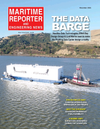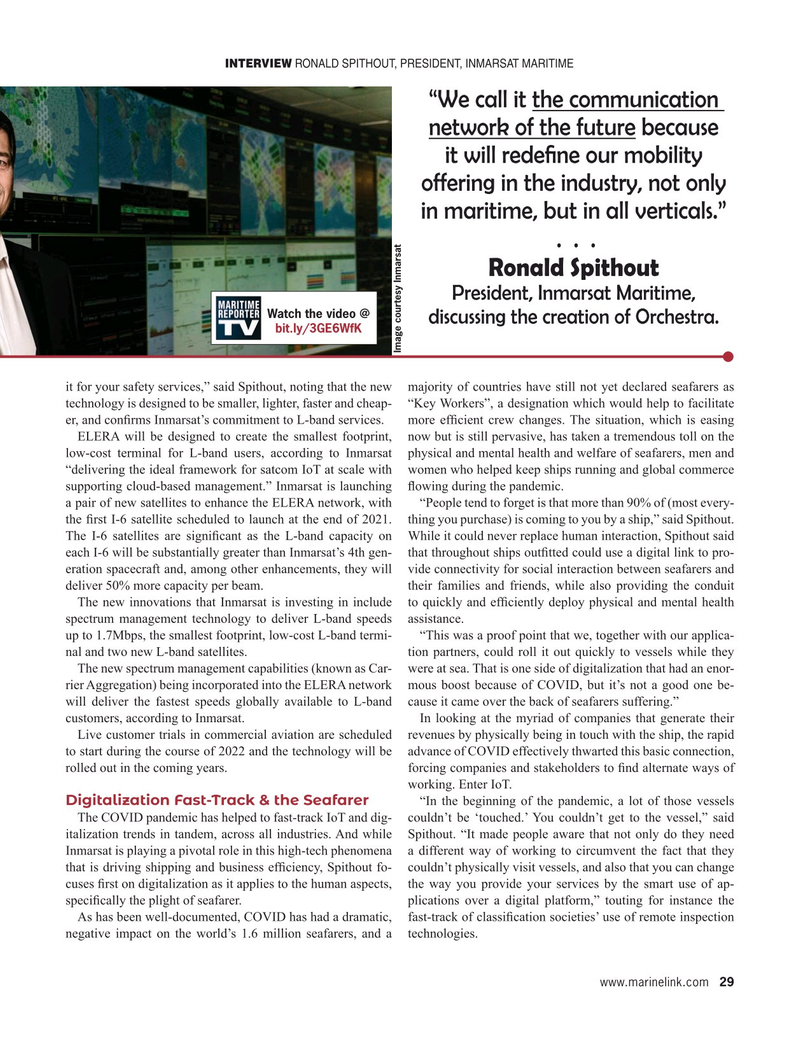
Page 29: of Maritime Reporter Magazine (November 2021)
The Workboat Edition
Read this page in Pdf, Flash or Html5 edition of November 2021 Maritime Reporter Magazine
INTERVIEW RONALD SPITHOUT, PRESIDENT, INMARSAT MARITIME “We call it the communication network of the future because it will rede? ne our mobility offering in the industry, not only in maritime, but in all verticals.” . . .
Ronald Spithout
President, Inmarsat Maritime,
Watch the video @ discussing the creation of Orchestra.
bit.ly/3GE6WfK
Image courtesy Inmarsat it for your safety services,” said Spithout, noting that the new majority of countries have still not yet declared seafarers as technology is designed to be smaller, lighter, faster and cheap- “Key Workers”, a designation which would help to facilitate er, and con? rms Inmarsat’s commitment to L-band services. more ef? cient crew changes. The situation, which is easing
ELERA will be designed to create the smallest footprint, now but is still pervasive, has taken a tremendous toll on the low-cost terminal for L-band users, according to Inmarsat physical and mental health and welfare of seafarers, men and “delivering the ideal framework for satcom IoT at scale with women who helped keep ships running and global commerce supporting cloud-based management.” Inmarsat is launching ? owing during the pandemic.
a pair of new satellites to enhance the ELERA network, with “People tend to forget is that more than 90% of (most every- the ? rst I-6 satellite scheduled to launch at the end of 2021. thing you purchase) is coming to you by a ship,” said Spithout.
The I-6 satellites are signi? cant as the L-band capacity on While it could never replace human interaction, Spithout said each I-6 will be substantially greater than Inmarsat’s 4th gen- that throughout ships out? tted could use a digital link to pro- eration spacecraft and, among other enhancements, they will vide connectivity for social interaction between seafarers and deliver 50% more capacity per beam. their families and friends, while also providing the conduit
The new innovations that Inmarsat is investing in include to quickly and ef? ciently deploy physical and mental health spectrum management technology to deliver L-band speeds assistance. up to 1.7Mbps, the smallest footprint, low-cost L-band termi- “This was a proof point that we, together with our applica- nal and two new L-band satellites. tion partners, could roll it out quickly to vessels while they
The new spectrum management capabilities (known as Car- were at sea. That is one side of digitalization that had an enor- rier Aggregation) being incorporated into the ELERA network mous boost because of COVID, but it’s not a good one be- will deliver the fastest speeds globally available to L-band cause it came over the back of seafarers suffering.” customers, according to Inmarsat. In looking at the myriad of companies that generate their
Live customer trials in commercial aviation are scheduled revenues by physically being in touch with the ship, the rapid to start during the course of 2022 and the technology will be advance of COVID effectively thwarted this basic connection, rolled out in the coming years. forcing companies and stakeholders to ? nd alternate ways of working. Enter IoT.
Digitalization Fast-Track & the Seafarer “In the beginning of the pandemic, a lot of those vessels
The COVID pandemic has helped to fast-track IoT and dig- couldn’t be ‘touched.’ You couldn’t get to the vessel,” said italization trends in tandem, across all industries. And while Spithout. “It made people aware that not only do they need
Inmarsat is playing a pivotal role in this high-tech phenomena a different way of working to circumvent the fact that they that is driving shipping and business ef? ciency, Spithout fo- couldn’t physically visit vessels, and also that you can change cuses ? rst on digitalization as it applies to the human aspects, the way you provide your services by the smart use of ap- speci? cally the plight of seafarer. plications over a digital platform,” touting for instance the
As has been well-documented, COVID has had a dramatic, fast-track of classi? cation societies’ use of remote inspection negative impact on the world’s 1.6 million seafarers, and a technologies.
www.marinelink.com 29
MR #11 (18-33).indd 29 11/4/2021 9:47:01 AM

 28
28

 30
30
